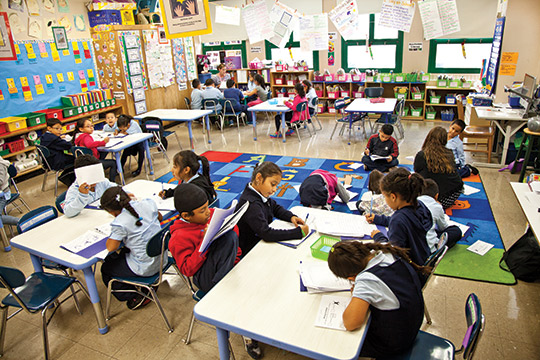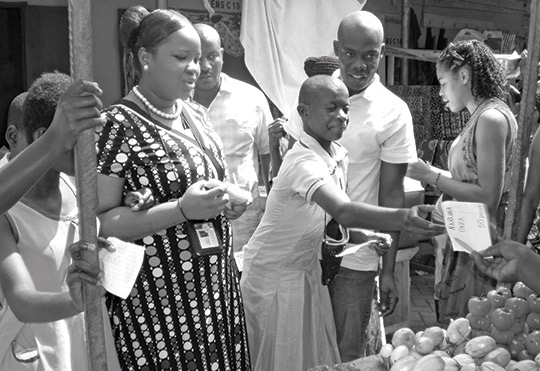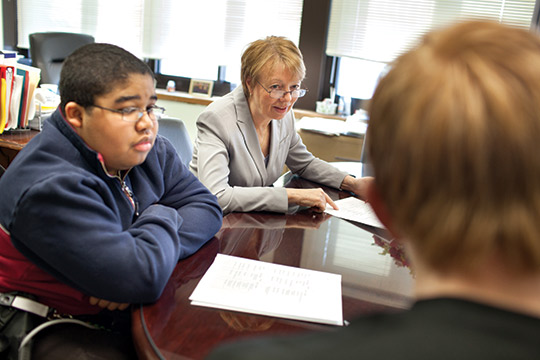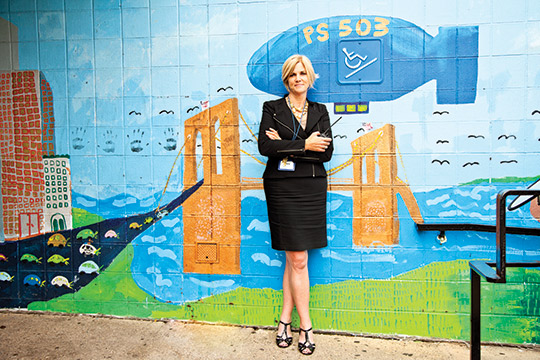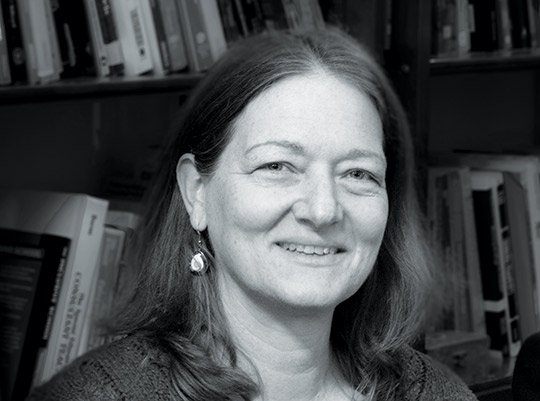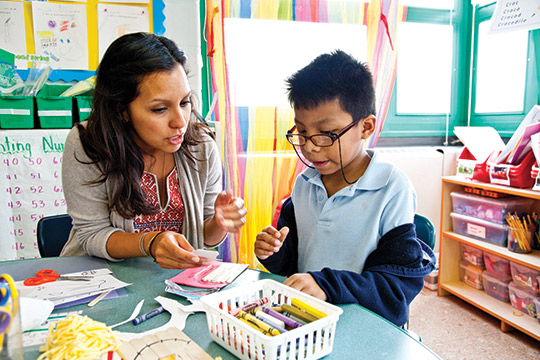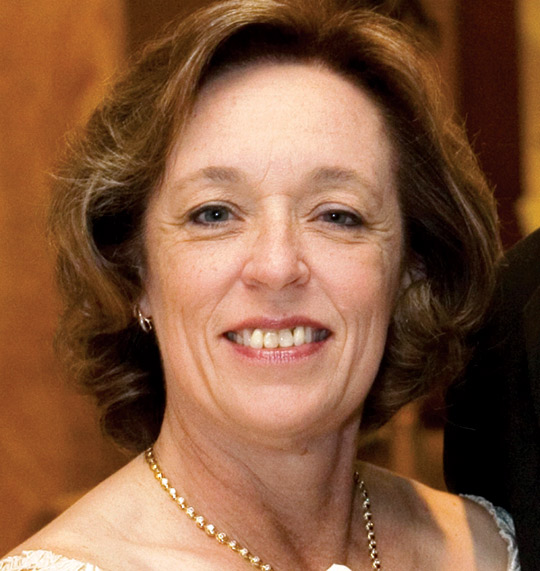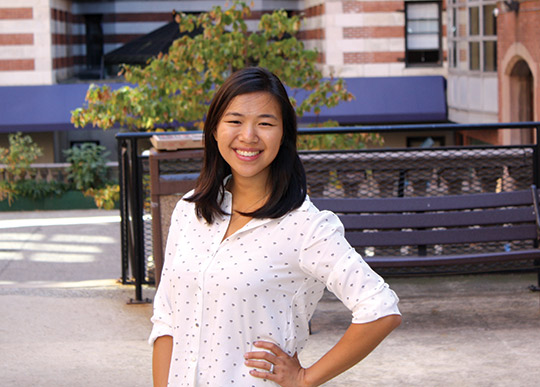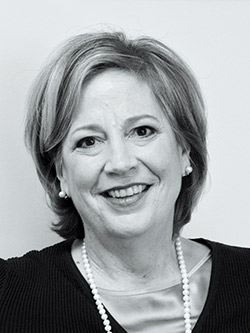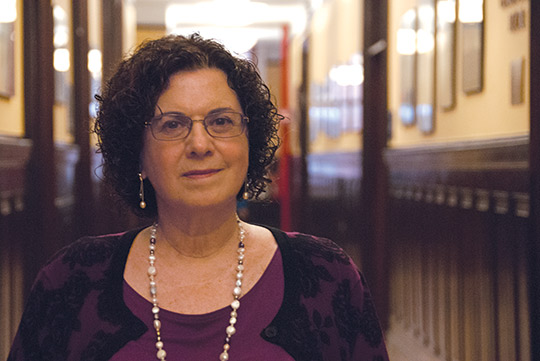All Together Now: TC's Blueprint for
Inclusive Education
On the morning six years ago when Principal Bernadette Fitzgerald launched inclusive classes at P.S. 503 in Brooklyn’s Sunset Park neighborhood, she was greeted with a scene reminiscent of the civil rights era: a frightened group of parents outside her office, protesting their children having to learn alongside “those kids”.
The issue wasn’t race, skin color or even some thinly disguised sense of class. Ninety-five percent of the school’s students live beneath the poverty line. A vast majority come from immigrant families, with more than half classified as English language learners (ELLs).
Rather, the target this time was disability, specifically Fitzgerald’s decision to begin mainstreaming the school’s 200-plus students who have Individualized Education Programs (IEPs) that qualify them for special education services. Aided by the citywide Teachers College Inclusive Classrooms Project (TCICP), P.S. 503 was adopting an integrated co-teaching (ICT) model that pairs a general education teacher and a special education teacher in a single classroom.
“We have students with autism, hearing impairments, developmental delays, learning disabilities, speech impairments, visual impairments and physical disabilities. We have students with feeding tubes,” Fitzgerald says. “When I first came here, we were interpreting federal mandates in a way that forced us to pull more kids out of classrooms for servicing than were staying in. There was no culture of learning. I felt we needed a model where kids got their services in the classroom.”
Since the passage in 1975 of the Education for All Handicapped Children Act, later reauthorized as the Individuals with Disabilities Education Act, federal law has required school districts to place students with disabilities in the “least restrictive” learning environment, preferably alongside the non-disabled. The law also mandates services to help English language learners overcome language barriers.
From those seeds have sprung today’s inclusive education movement, which calls for all students — regardless of ability or need — to learn the same curriculum together. Inclusion initiatives are proliferating in districts ranging from Clark County, Nevada, to Charlotte-Mecklenburg, North Carolina, to Madison, Wisconsin. In New York City, at the behest of Laura Rodriguez, the city’s first Deputy Chancellor for Students with Disabilities and English Language Learners, Teachers College (through TCICP) has been working with schools like P.S. 503 to help teachers accommodate a new influx of students with special needs.
Certainly, a commitment to social justice underscores the movement’s rationale.
“Inclusive education urges us to take up the challenge inherent in human diversity, which is to see all the different variables of diversity as richness,” says Celia Oyler, Professor of Education and TCICP founding Director. “The focus is on strengths and capacities instead of deficits.”
Oyler and other advocates maintain that all children benefit from the inclusive model because, by learning to recognize strengths in one another, they expand their definitions of what strengths are. They also learn to care for one another, creating the kind of community so often lacking beyond school walls.
But in a society that increasingly gauges education outcomes by standardized test scores, such social justice arguments sometimes fail to carry the day — including with those who fear that children with disabilities will receive less support. Writing in The New York Times, Illinois parent Margaret Storey argued that it would be better simply to “destigmatize these children and the special schools they need.”
Advocates respond by citing a body of research showing inclusion’s benefits. In particular, a 2002 review of 14 studies disseminated by the Statewide Parent Advocacy Network found “compelling support” for the idea that inclusive education produces outcomes that are at least as successful (at no additional cost) as those achieved using separate settings for all students.
But just mixing general education and special education students doesn’t make the learning experience inclusive. Schools must create conditions in which inclusive classrooms can succeed. School systems must invest in professional development to help teachers serve an expanded mix of learners. And colleges of education must equip the next generation of educators to eschew labels and instead view learners on a continuum.
“If we are doing inclusive education right, we can’t possibly talk about ‘inclusion classrooms,’ because every classroom should be inclusive,” says Srikala Naraian, Associate Professor of Education, who spent 10 years as a special-ed teacher. “Yet if we want a world in which everybody is educated together in a system free of privilege, we have to understand inclusive education in a way that speaks to teachers on the ground.”
Laying the Groundwork for Success
At Teachers College, where in 1915 Elizabeth Farrell and Leta Hollingworth established the nation’s first program in special education, faculty, students and alumni are taking the lead in making inclusion work.
“The whole idea behind inclusion is to give kids access to a good curriculum and to their non-disabled peers,” says Carol Burris (Ed.D. ’03), Principal of Long Island’s South Side High School in Rockville Centre, New York, which has won national recognition for “de-tracking” its students. “Some schools have supposedly inclusive classrooms where all the special needs students are placed together, with a low-level curriculum and a few disruptive gen-ed kids thrown in. That is not true inclusion, and it has all of the problems associated with the culture of low-track classes. So for inclusion to succeed, you’ve got to make sure that the vast preponderance of kids in a classroom are non-disabled.”
General-ed kids, too, need an ideal classroom mix for the inclusive model to work in their favor.
“Inclusion gives the general education kids an additional teacher in the room,” Burris adds. “When that teacher explains things in different ways for special-ed students, it promotes better understanding for the whole class. You’ve got to make sure the number of special-ed kids stays small so that the special education teacher knows what her students are getting, or not getting. We provide teaching assistants when the special education teacher is not in the room. They take field notes all through class on the problems that individual kids are having.”
But even under the best working conditions, educators need specific, tried-and-true strategies for helping students. While many current teachers do not hold degrees in special education, they do possess a wealth of knowledge drawn from real-world experience — knowledge that, with guidance by experts, can be refined and shared.
That’s the premise of TCICP, now in the fifth year of a con¬tract with New York City. Among its other activities, the project has enabled hundreds of educators to take part in monthly “inquiry teams” that explore different issues and present to a professional development conference at year’s end. From those efforts, the project has amassed a growing online library — free for anyone to download at tcicp.com — of teacher-devised inquiries with titles such as “How I Learned to Craft Meaningful IEPs,” “Creating Access for All Kinds of Learners,” “De-escalating Problematic Behavior” and “Access through Integrated Technology.” Each draws on educators’ own knowledge and experience.
“We’re not interested in models,” Oyler says. “We’re interested in helping teachers to solve local problems, so the work doesn’t scale up — it spreads out.”
At P.S. 503, for example, Bernadette Fitzgerald wanted to ensure that co-teachers were really co-teaching and “not just distinguishing themselves by, ‘Oh, I’m the ESL teacher and I’m only addressing ESL needs.” TCICP facilitator Erika Hughes Hooper functioned “like a marriage counselor,” Fitzgerald says, helping paired teachers to share knowledge and strategies. “Now, regardless of their licensing, they’re thinking about the class as one community and about how they can best serve the children.”
In TCICP inquiries, students with disabilities have held professional development clinics to help their teachers identify the most helpful assistive technologies. Communities have reassessed the knowledge and perspective that their oft-under-valued parent coordinators can provide. Math teachers have learned to adapt curricula to the developmental thinking of each student. And paraprofessionals have been empowered to become involved in lesson planning and other core aspects of teaching.
TCICP is helping the city raise its game, but for many current teachers inclusion may always be something of an acquired taste. The greater promise lies in equipping future teachers to think about inclusion from the get-go — an area in which TC is also breaking new ground.
In 2011, backed by a $1.25 million federal grant, the College launched QUIERE (for “quality universally inclusive early responsive education”), a master’s degree program that provides pre-service teachers with triple certification in early childhood general education, early childhood special education and bilingual education in Spanish, Mandarin, French or Korean.
“When Carmen Fariña became New York City’s Schools Chancellor, she called for teachers who understand the whole child, and that’s what QUIERE is all about,” says Mariana Souto-Manning, Associate Professor of Early Childhood Education and QUIERE Director and Co-Principal Investigator (with Professor Emerita and early childhood authority Celia Genishi). “The idea is to preempt bifurcation of special-ed and bilingual education, in which a kid gets multiple professionals, and instead produce the kind of teacher who is ready to educate an English language learner or a child with disabilities.”
“Our focus is on how teachers can create an environment that supports children and brings them together in a community,” says Susan Recchia, Professor of Education, who recently coauthored Inclusion in the Early Childhood Classroom: What Makes a Difference (Teachers College Press). “We look at assumptions that are too often taken for granted — ways that we end up marginalizing children with dis¬abilities instead of drawing on the strengths they have to offer.”
QUIERE graduates like Jennifer K. Lopez, who now teaches at P.S. 75 on Manhattan’s Upper West Side, are taking that idea to heart.
Last year, for example, in Lopez’s officially monolingual second-grade class, one breakthrough moment occurred when a little boy named Carlos, who had been a silent observer for much of the year, finally wrote “cinco” in answer to a math problem.
“He spelled it ‘seenco,’ but the important thing is that he felt comfortable enough to do it,” Lopez says. “It also happened to be the right answer.”
At the Hiketi Community Charter School in the Bronx, QUIERE graduate Peter Kim empowers students with jobs that make them responsible to their peers but also fit their own abilities. A student with lower reading levels, for instance, might be given the job of reading assistant.
“In an ELA [English Language Arts] block, that student might be the first called on to identify sight words,” Kim says. “You build it in so he’s not identified as having a special need.”
Five years ago, to prepare teach¬ers working with older students with IEPs, TC created a Secondary Inclusive Education [SIE] track as part of TR@TC, its residency program. “Certification is categorical, but students are not — regardless of their age, grade or labels assigned to them, these learners come as whole people, who may be experiencing multiple vulnerabilities,” says Vice Dean A. Lin Goodwin. “So we need teachers at all levels who are ready, regard-less of certification area, to be first responders.”
As initiatives like TCICP, QUIERE and SIE take route; school leaders face one other challenge: selling inclusive education to parents.
In Rockville Centre, by all ac-counts, Carol Burris and South Side High have benefited mightily from the adroit efforts of District Superintendent (and TC alumnus) Bill Johnson to sweeten inclusion with other measures.
“Bill used his position as a leader to influence this upper-middle-class community,” recalls TC Trustee Nancy Douzinas, President of the Long Island-based Rauch Foundation, which focuses regionally on the needs of children and families. “He brought in the International Baccalaureate program and sold the idea that everyone’s scores would rise.
“It demonstrates that leader’s doing the hard work of putting themselves out there in the community is the key. You have parents with belief systems in which it is not always natural to see inclusion as beneficial. So we have to communicate more effectively to parents about inclusion’s advantages.”
Six years removed from that frightened group of parents outside her office, P.S. 503’s Bernadette Fitzgerald concurs. “We had to educate families to give inclusion a try,” she says. “Now they appreciate the attention that their children get with two teachers in the classroom.”
For Douzinas, the case for inclusive education must ultimate¬ly rest on outcomes. “It’s not just about the ratio of teachers to children,” she says. “In the end it’s about what really works.”
Inclusive Change Agent: O’Neill Fellow Bonnie Chow
By Phoebe Jiang
TC O’Neill Fellow Bonnie Yuen Pun Chow’s parents moved to the United States from Hong Kong to give their daughters a better education. Chow arrived in first grade terrified and speaking no English. Fortunately, Bonnie Brooks, a teacher of English as a second language, took her in hand.
“She taught me the ABCs and also about America,” Chow recalls. “She introduced me to hamburgers and milkshakes and invited my family over to celebrate Independence Day. She taught me to navigate American culture without being ashamed of my own ethnicity. She showed me just how personal and powerful education can be.”
Chow planned to become a doctor but decided to pursue a career in inclusive education as she became more aware of disparities in the school system.
The O’Neill Fellowship at Teachers College has been a key step. Created in 2013 by an $11 million commitment from Trustee Emerita Abby M. O’Neill, the Fellowships enable recipients to earn dual certification in areas of great need for New York City schools, such as science/ inclusive education, elementary education/ bilingual or TESOL. Thanks to the O’Neill Fellowship Program, students graduate with as little debt as possible.
“The O’Neill Fellowship has given me access to the necessary tools and experiences to be a powerful and effective agent of change in students’ lives,” Chow says. “I’ve learned from a community of extraordinary faculty members and mentors.
“I hope I never stop learning with and from children. And I hope I never tire of reflecting and examining my own learning, practice and lifestyle so that I can grow as a student and an educator.”
International Inclusion: It’s in the Cards
By Siddhartha Mitter
At a market in Ghana, a child with a communication disability shows a vendor a laminated card with a picture — tomatoes paw paws, okra — and a value in cedis, Ghana’s cur¬rency. As most kids here do, she is shopping for food for her family.
This simple transaction is revolutionary. Many nations have neither the laws nor the resources to educate disabled children, who often are stigmatized, excluded from schools and viewed by their families as a burden rather than a resource.
Within Ghana’s general education cam¬puses, Unit Schools devoted to improving prospects for students with autism and intellectual disabilities are modeling inclusive education for other African countries.
Since 2008, a TC project led by Catherine Crowley, Distinguished Senior Lecturer in Speech and Language Pathology, brings 15 TC Speech/Language Pathology students each year to work with the Unit Schools. The cards, developed in collaboration with Ghanaian teachers and parents of students with disabilities, are one fruit of their efforts.
“It is thrilling to hear the market sellers call the students by name and watch the joy of students able to fulfill a traditional role of a Ghanaian child,” Crowley says.
Thanks to the TC team, Unit School parents and teachers create “communica¬tion passports” that describe the needs of students who are lost or in other difficulties. Students in one school’s vocational training program sewed bags made from traditional Ghanaian fabric. The TC team then estab¬lished a market and provided funding to replicate the program.
“Because each student brings home a portion of the sales, the message is clear — ‘Disability is not inability,’” says Crowley.
Through ongoing collaboration with Unit School teachers, the TC program has boosted the image of special education. Innovators like Crowley’s colleague Belinda Bukari, head teacher at the Unit School at the Effiduase Methodist School, are win¬ning new respect.
“In the past, people thought Belinda was crazy to work with these students,” Crowley says. “But now she is respected and invited to speak at churches and on the radio.”
Getting People Together
By Joe Levine
In the early 1990s, the Santa Clara, California public schools approached Charmaine Warmenhoven to fund teacher training in inclusive education. “I said great, but I wanted something systemic, not just a one-off,” says Warmenhoven (M.A. ’75), then Associate Director of Special Ministries for the Diocese of San Jose, California.
Warmenhoven, whose 30-year career in special education included directing a school for students with special needs and working with deaf children and adults, has since helped fund the Inclusion Collaborative, a program within the Santa Clara Office of Education that promotes inclusive education practices across the county’s 32 districts. Initially for early childhood and special education teachers, the Collaborative now supports a “community of practice” aimed at all interested K—12 teachers.
“Inclusive education is Charmaine’s lifelong passion,” says Inclusion Collaborative Manager Janice Battaglia. “She has a vision for change that extends nationwide.”
For a K—12 expansion, Warmenhoven linked the Inclusion Collaborative with TC, where she studied learning disabilities and behavior disorders. Celia Oyler, who leads the Teachers College Inclusive Classrooms Project (TCICP), has since video-conferenced with Santa Clara County school leaders. Inclusion Collaborative coaches and TCICP facilitators have also spoken online. And TC’s Susan Recchia, co-author of Inclusion in the Early Childhood Classroom: What Makes a Difference, spoke at an Inclusion Collaborative conference this fall.
Recently tapped by the Special Education Division of the California Department of Education to help lead inclusion efforts statewide, the Inclusion Collaborative is developing a broader community of practice that will include Oyler’s continued support. Reflecting on her own promotion of inclusive education, Warmenhoven says, “It was just a matter of getting people together.” Which, after all, is what inclusion is all about
Inclusive Voices: Celia Oyer
“Oyler and other advocates maintain that all children benefit from the inclusive model because, by learning to recognize strengths in one another, they expand their definitions of what strengths are. They also learn to care for one another, creating the kind of community so often lacking beyond school walls.”
Inclusive Voices: Susan Recchia
“Our focus is on how teachers can create an environment that supports children and
brings them together in a community,” says Susan Recchia, Professor of Education. “We look at assumptions that are too often taken for granted — ways that we end up
Inclusive Voices: Nancy Douzinas
“Leaders doing the hard work of putting themselves out there in the community is the key,” says TC Trustee Nancy Douzinas, President of the Long Island-based Rauch Foundation. “You have parents with belief systems in which it is not always natural to see inclusion as beneficial. So we have to communicate more effectively to parents about inclusion’s advantages.”
Published Friday, Dec. 19, 2014
